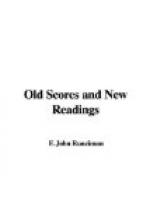His operas stand at the parting of the ways. In them we find the fullest measure of dramatic truth combined with the most delicious ear-tickling. But it is safe to say that Mozart is the only composer of Italian operas who ever succeeded in combining the two things thus, for in Gluck there is short measure of sheer beauty, and in Handel—who used the oldest form—no attempt at drama. Mozart, like Gluck, had no disciples—only the second-rate men have disciples; but their example, and the tendency which they represented, had a curious result. Before their time all opera-writers had been avowed ear-ticklers. But after them, and especially after Mozart, the old line of composers may be observed to have split up into two lines, the one doing the old ear-tickling business, the other trying to express dramatic movement, and their thought and feeling, in the old medium. The first of these lines has not been broken to this day: Rossini came, and, after Rossini, Donizetti, Auber, Bellini, Meyerbeer, and the rest; and ear-tickler follows ear-tickler unto this day. The second line in its turn quickly split into those who, not content with the form, sought to alter it, and those who, quite content with it, went gaily on, turning out opera after opera, dealing with modern subjects in the old-fashioned way. Of these last Gounod must be reckoned the chief; and he began, not where Mozart left off, but with the Mozartean method of the “Don Giovanni” period. Now, it is of the very essence of the Italian opera of the Gluck-cum-Mozart model that it enables a composer to represent moments. The drama does not unfold gradually, as it does in the music-play, with its continuous flow of music marking the subtlest changes. It unfolds in jerks, each number advancing it a stage; so that Gluck never got any appearance of continuity whatever, while Mozart got it only by the consummate tact with which he arranged his pictures, and by the exciting pace at which he passes them before us. The figures seem to move, as in the Kinetoscope, or its forerunner the Wheel of Life: the Mozartean opera, when most dramatic, is a musical Wheel of Life. Gounod possessed neither Mozart’s tact nor his fiery energy. Neither was called for in “Faust,” which is not a drama, but a series of scenes, of crucial moments, from a drama; and since the moments were moments charged with the one feeling which Gounod appears to have felt very strongly or to have had the faculty for expressing, he is here at his very best. There was nothing spiritual in love as Gounod knew it—it was purely animal, though delicately animal; and Marguerite remains, and will remain, as the final expression of the most refined and voluptuous form of sensuality. What he had done in “Faust” he attempted to do again, with sundry differences, in “Romeo and Juliet”; and here the method which had served him so faithfully and so well in “Faust” utterly broke down. In “Faust” there were virtually but two characters, Faust and Marguerite,




